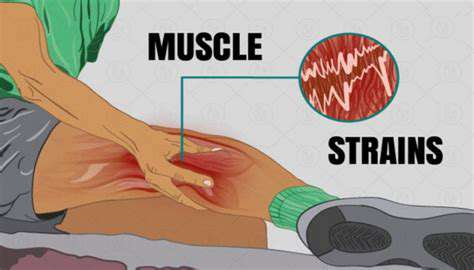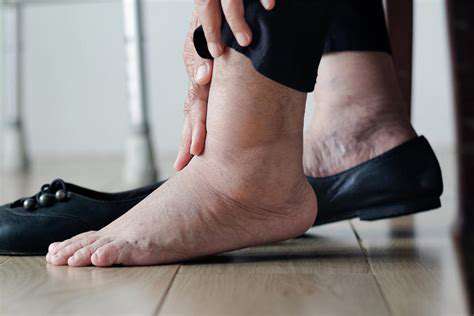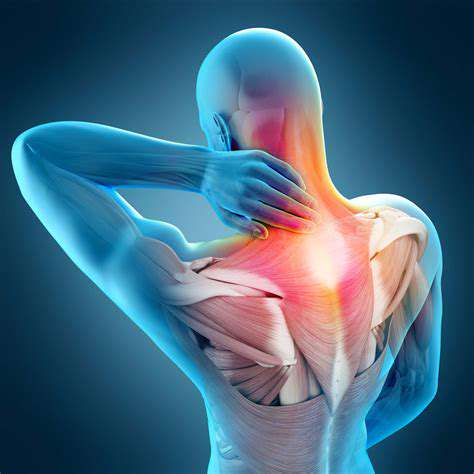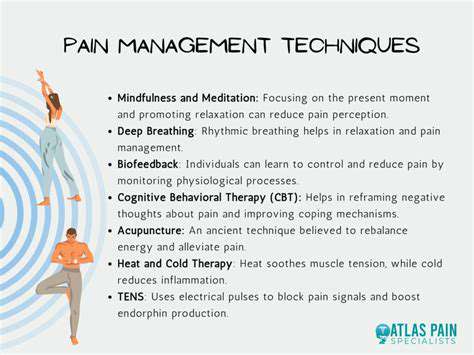Effective Ways to Manage Muscle Strain and Tension
What Causes Muscle Strain and Tension?

Common Causes of Muscle Strain
Muscle strain can occur for a variety of reasons, but one of the most common causes is overuse of the muscle during physical activities. When the muscles are engaged in repetitive motions or pushed beyond their normal limits, they can become strained. This often happens in sports, especially when athletes suddenly increase the intensity or duration of their training.
Another significant factor that contributes to muscle strain is poor posture or improper technique. Whether it's lifting heavy weights or simply sitting at a desk for prolonged periods, maintaining the correct posture is crucial in preventing unnecessary strain. Developing bad habits can lead to muscle fatigue and pain.
Additionally, a lack of proper warm-up and stretching can leave muscles unprepared for strenuous activities. If muscles are not adequately warmed up, they are more likely to experience strain during exercise. Therefore, it is essential to incorporate a routine that includes both warm-up exercises and stretching to enhance muscle flexibility.
Emotional and Psychological Factors
Muscle tension is not solely a physical issue; emotional stress can significantly impact muscle health as well. Strong emotions such as anxiety, anger, or stress can lead to muscle tension, particularly in the neck, shoulders, and back. Recognizing the connection between emotions and physical tension is crucial for overall well-being.
Implementing stress-reduction techniques, like mindfulness or deep breathing, can help alleviate muscle tension caused by emotional strain. Regularly engaging in relaxation exercises can provide relief and prevent muscle strains that stem from psychological factors. These techniques promote a sense of calm and help to release pent-up tension in the body.
Moreover, it's important to develop coping strategies for managing daily stressors. Developing healthy habits such as regular physical activity, sufficient sleep, and social support can also mitigate the effects of emotional stress on muscle health. Consistently prioritizing these aspects can contribute to better muscle relaxation and recovery.
Recognizing the Symptoms

Identifying Muscle Strain Symptoms
Muscle strain can manifest in several ways, and recognizing these symptoms is crucial for effective management. Common signs include sharp or dull pain, swelling, and limited range of motion.
If you notice persistent pain or swelling, it's essential to seek medical advice. Understanding the specific symptoms of muscle strain can help differentiate it from other injuries.
Common Causes of Muscle Strain
Muscle strains often occur due to overexertion or improper movements during physical activities. Factors such as sudden twisting motions, lifting heavy objects incorrectly, or engaging in rigorous exercise routines can contribute to strains.
Being aware of these causes can help in taking preventive measures. Proper warm-ups and stretching before activities are fundamental to reducing the risk of strains.
Immediate First Aid for Muscle Strain
When you experience a muscle strain, applying the RICE method—Rest, Ice, Compression, and Elevation—as a first response is vital. Resting the injured muscle helps prevent further damage.
Icing the area reduces swelling and alleviates pain, while compression using an elastic bandage offers support. Elevating the injured area can aid in minimizing swelling.
Long-Term Management Strategies
Incorporating strength training and flexibility exercises into your routine can significantly help in preventing future strains. Focus on gradually increasing the intensity of your workouts to allow your muscles to adapt.
Consulting with a physical therapist can provide personalized exercises and insights. These strategies will not only assist in recovery but also enhance overall muscle resilience.
When to Seek Professional Help
While many muscle strains can be managed at home, certain conditions warrant professional intervention. If the pain is debilitating, or if you experience symptoms like fever or a visibly deformed limb, it’s necessary to consult a healthcare provider.
Early intervention by healthcare professionals can prevent complications and ensure a proper recovery timeline. Knowing when to seek help ensures that you are taking the appropriate steps towards healing.
Effective Prevention Strategies
Understanding Muscle Strain and Its Causes
Muscle strain occurs when muscle fibers are overstretched or torn, often resulting from excessive force or repetitive activity. Understanding how strains occur is essential for developing effective prevention strategies.
Common causes of muscle strain include heavy lifting without proper technique, engaging in sports without adequate warm-up, and sudden, forceful movements. Awareness of these factors can help individuals take proactive measures to avoid injuries.
Injuries are more likely to occur when muscles are fatigued or underprepared. Therefore, recognizing the importance of conditioning is critical for athletes and active individuals alike.
Additionally, factors such as muscle imbalances, dehydration, and inadequate nutrition can contribute to muscle strain. By understanding the underlying causes, individuals can tailor their approaches to reduce the risk of injury.
Incorporating Proper Warm-Up and Cool-Down Practices
A thorough warm-up routine can significantly reduce the risk of muscle strain by increasing blood flow and flexibility in the muscles. Dynamic stretching before activities helps prepare the body for physical exertion.
Engaging in a consistent cool-down routine is equally important, as it aids in recovery and prevents the muscles from tightening post-activity. Static stretches should be incorporated during the cool-down phase to improve flexibility and support muscle recovery.
Warm-ups should ideally last 10 to 15 minutes and include exercises that mimic the movements to be performed. This gradual approach helps the body adapt to the demands it will face.
Both warm-up and cool-down routines should be tailored to the specific activities being performed. This customization allows individuals to target muscle groups that may be more prone to strain, further reducing the risk of injury.
Maintaining Proper Hydration and Nutrition
Staying hydrated is vital for muscle function and overall health. Dehydration can lead to decreased muscle efficiency and increased susceptibility to cramps and strains. Individuals should aim to drink water before, during, and after exercise to maintain optimal hydration levels.
Nutrition plays a crucial role in muscle strength and recovery. A balanced diet rich in proteins, healthy fats, and complex carbohydrates provides the nutrients necessary to support muscle repair and growth.
Particular attention should be paid to electrolytes, such as potassium and sodium, which are essential for muscle function. Replenishing these nutrients, especially during intense workouts, can help prevent muscle strain.
Incorporating nutrient-dense foods like fruits, vegetables, lean proteins, and whole grains can promote muscle health. A nutrition plan tailored to individual activity levels and goals can facilitate better performance and reduce the risk of injury.
Effective Treatment Options
Understanding Muscle Strain and Tension
Muscle strain and tension are common issues that many people experience due to various factors, including excessive physical activity, poor posture, or even stress. Understanding the underlying causes can help in effectively managing these conditions. When a muscle is overstretched or torn, it results in a strain, which can cause pain, swelling, and limited mobility.
Tension, on the other hand, generally refers to the muscle being tight or contracted, often due to stress or prolonged periods of inactivity. This can lead to discomfort and a feeling of stiffness that can persist if not addressed properly.
Identifying the symptoms of muscle strain versus tension is crucial for effective treatment. Symptoms of strain may include sudden pain during activity, bruising, or a "snap" feeling during the injury, while tension usually manifests as a dull ache that may worsen with certain movements.
Immediate care for both conditions often involves rest, ice application, and elevation of the affected area. Knowing how to differentiate between the two can help individuals seek the appropriate medical advice and avoid unnecessary complications.
Incorporating regular warming up and stretching exercises into your routine can significantly help in preventing muscle strain and tension. Staying aware of your body’s signals is key to maintaining a healthy and active life.
Practical Treatment Strategies
When it comes to managing muscle strain and tension, there are several effective treatment options. One of the most recommended approaches is the RICE method, which stands for Rest, Ice, Compression, and Elevation. This method is especially beneficial soon after an injury occurs, helping to reduce swelling and pain.
Physical therapy is another vital option for strained muscles or tensions. Therapy can provide tailored exercises that target specific muscle groups, helping to strengthen them and improve flexibility, thereby minimizing the risk of future injuries.
Additionally, over-the-counter medications such as NSAIDs (non-steroidal anti-inflammatory drugs) can help alleviate pain and inflammation. Always consult with a healthcare professional before taking any medication, especially if you have pre-existing health conditions.
Massage therapy has also been shown to be effective for relieving muscle tension. Various techniques can help promote relaxation, increase blood flow, and enhance overall muscle recovery. Regular massages can aid in maintaining muscle health and preventing future strains.
Lastly, adopting ergonomic practices in your daily activities can play a crucial role in managing muscle strain and tension. Whether it’s using proper lifting techniques or arranging your workspace to support good posture, small changes can lead to significant long-term benefits for muscle health.







